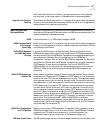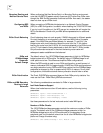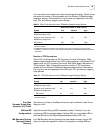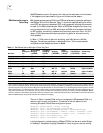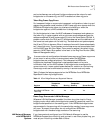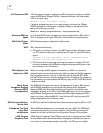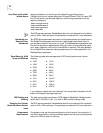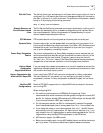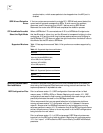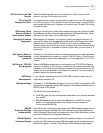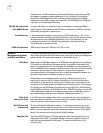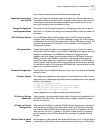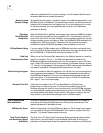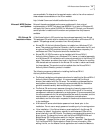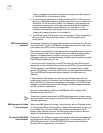
WAN Protocols and Services Notes 55
Dial Idle Timer The dial idle timer is not accurate and it will take a client longer to idle out than is
configured. For a 180 second dial idle time it takes approximately 8.5 minutes for
the client to idle out if no traffic is ever sent. To workaround this problem, disable
bootp on !0 by entering the following command:
Setd !0 -bootp control=disable"
Disaster Recovery on
Ports Without Leased
Lines
The Port Service DialControl parameter controls port attributes for a dial-up port in
the event the bandwidth set for a leased line drops below what has been set as
the normal bandwidth. Setting this parameter to DisasterRecovery for a port
without leased lines prevents port idle out.
DTR Modems DTR modems should not be configured as a dynamic path and a dial pool.
Dynamic Paths Dynamic paths might not be released back into the dial pool from the port if an
incoming call arrives during a disconnect state. If the SHow -POrt PAths command
indicates that a path from the dial pool is attached to a port but is no longer in
use, it can be released by re-enabling the port.
Frame Relay Congestion
Control
The current implementation of Frame Relay congestion control requires that you
set the committed burst size (Bc) and the committed information rate (cir) to the
same value so that the time interval (Tc) equals 1 second using the formula
Tc= <Bc>/<cir>. If Tc is not 1 second, the Frame Relay frames may be erroneously
dropped due to the incorrect calculation of the throughput rate threshold.
History-Based
Compression
Negotiation Failure
If you are using history-based compression on a line with excessive errors and the
negotiation attempts exceed the retry count, the device must be rebooted to clear
the condition and reset the retry count.
History Compression Not
Allowed With Async PPP
A port using Async PPP (AT dial) cannot be configured for history compression.
The user interface will not prevent you from configuring the port for history
compression, however, if history compression is selected the path will not come
up.
Multilink PPP
Configurations
Multilink PPP (MLP) is supported for multiple WAN links connected to the same
port running PPP.
When configuring MLP:
■ For maximum performance on a NETBuilder II bridge/router, 3Com
recommends that similar hardware interface types be configured for each MLP
bundle. For instance, bundle HSS modules with HSS modules, and bundle HSS
3-port module links with HSS 3-port module links.
■ For the best performance, use MLP on interfaces with matched line speeds.
Avoid mismatched baud rates of ratios greater than 10 to 1 for bundled links.
■ If your baud rate ratios on two links are greater than 4 to 1, the MLP feature
automatically turns off fragmentation. For baud ratios of less than 4 to 1, you
may choose to turn off fragmentation for performance considerations. Turn off
fragmentation using the MlpCONTrol parameter in the PPP Service.
■ MLP does not support the HSSI module.
■ Before you re-enable a port running MLP, disable the port and allow the remote
port to go down. This action prevents loss of packet sequence numbers



